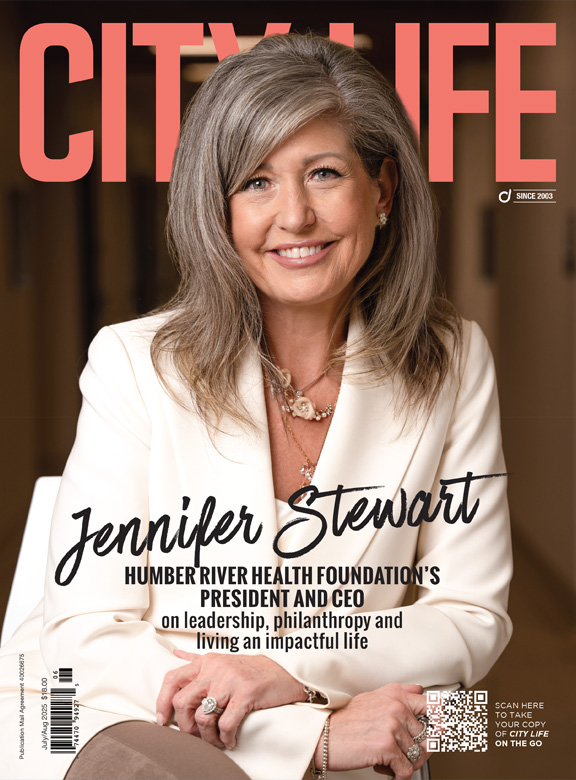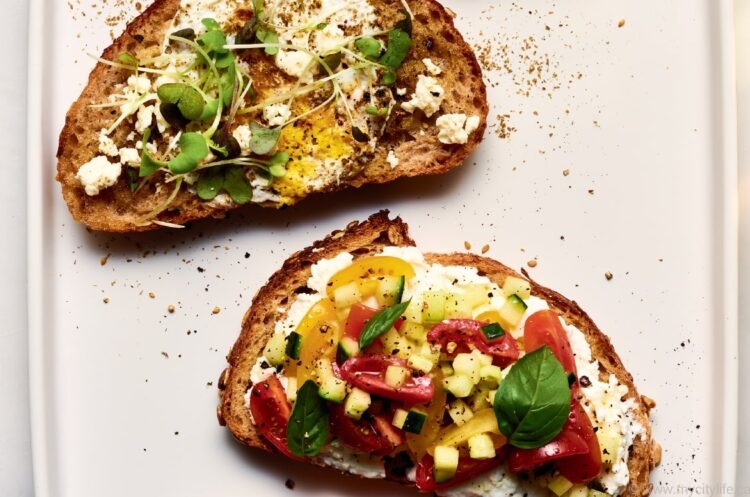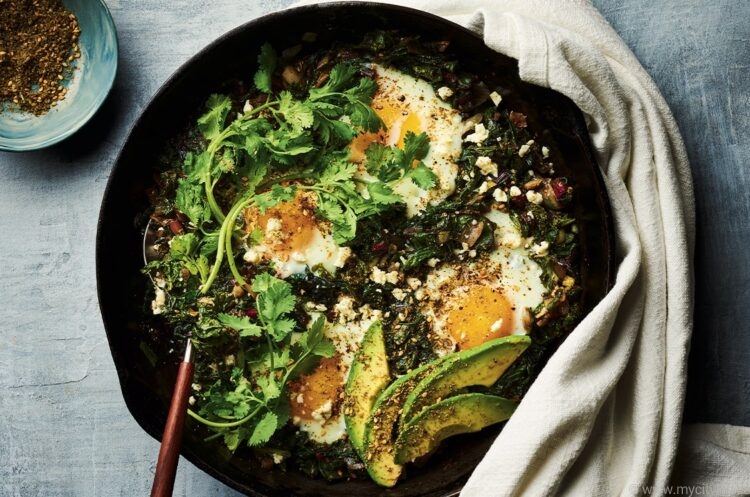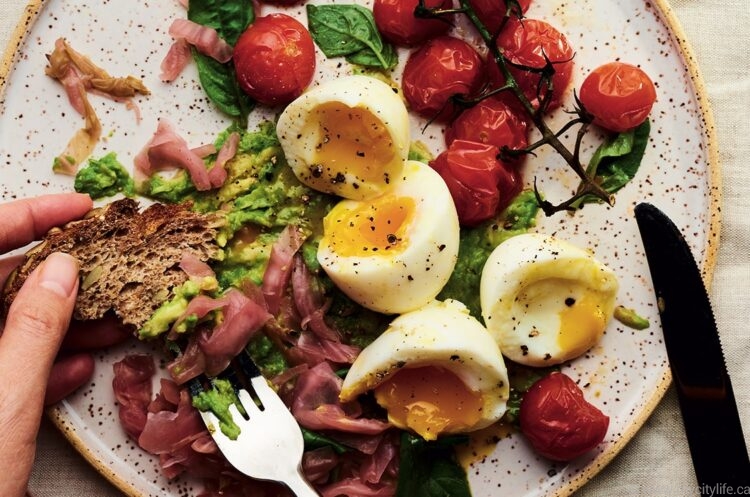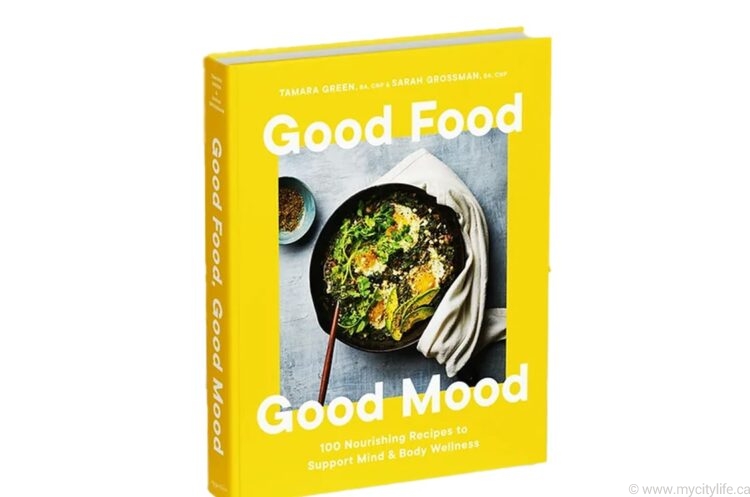Tamara Green & Sarah Grossman: The Good Food, Good Mood Mantra
The power that food has on our emotional well-being.
Is wolfing down a favourite chocolate bar or running to the local barista for a hit of caffeine part of your late-afternoon itinerary?
If so, you are not alone.
So many of us either skip lunch or eat at our desks from containers of takeout food that has more bulk than nutrition and gives us a blood-sugar spike and then energy crash that deplete us well before our day is done.
“It is well known that “you are what you eat,” and good food can improve mental health and stabilize moods as well as support physical health.”
So the question we need to ask ourselves is, can the types of food we eat affect and improve our moods?
“Our gut is our second brain,” says Sarah Grossman, who, along with co-author Tamara Green, has penned a new book, Good Food Good Mood: 100 Nourishing Recipes to Support Mind & Body Wellness (published by Appetite by Random House), which is being released in March of 2024. It is a book that the two initiated shortly before the start of the COVID-19 pandemic; as it wore on, they became even more aware of food-mood correlations, and especially attuned to the benefits of eating “supportive foods” and the effect they could have on our moods and mental health.
“Blood sugar levels are highly important to be aware of, something that we talk a lot about in the book,” Grossman says. “The stability of our moods is related to either our balanced or elevated blood sugar levels, which can affect the mood equation, making us feel tired, anxious, stressed or irritated.”
Both graduating from the Institute of Holistic Nutrition in Toronto in 2010, Green and Grossman founded their company, The Living Kitchen, that same year. One of the partners’ first jobs was conducting classes for outpatients at the Centre for Addiction and Mental Health (CAMH), to provide them with an overview of how healthy food can make a significant difference to one’s mental health.
From there, the entrepreneurs branched out to meal-delivery services in the Toronto area and a private-chef service. Their international clients range from celebrities to couples looking to make easy dinners, from families with picky eaters to women experiencing anxiety as a result of infertility or giving birth, and from those struggling with depression, dementia or debilitating gut issues to cancer patients and their caregivers. In fact, the authors’ first book, The Living Kitchen: Nourishing Whole-Food Recipes for Cancer Treatment and Recovery (Appetite by Random House, 2019), provides achievable eating solutions to be used in conjunction with cancer treatments and protocols.
The authors’ mission in writing Good Food, Good Mood was to provide nutritious food solutions for readers that are accessible, affordable and delicious, as well as provide practical, adaptable tools for living according to their “Good Food, Good Mood” mantra.
“We wanted to ensure that readers understand the link between food, moods and mental health. Our hope is that readers, by following the suggestions in this book, which include adding protein to every meal as well as including an array of colourful vegetables and plants, can make a difference in their lives both physically as well as mood-wise,” says Grossman. “It is important to eat in a way that supports our brain and gut health.”
But don’t worry, bons vivants, foodies, epicureans, hedonists, foodaholics, connoisseurs, gastronomists, gourmands and gourmets, your palates will still be happily intrigued and bellies satiated by the diverse and colourful menu choices offered within the pages of Grossman and Green’s book.
“The more variety of plants we eat feeds the microbes in our guts and helps form our neurotransmitters,” Grossman says. “In fact, microbes help support our brain function. Neurotransmitters also have an impact on our mood — they can make us feel happy, motivated, focused and alert. And while eating good food isn’t the only component to positive mental health, protein-rich foods can be building blocks to create neurotransmitters.”
“THE MORE COLOUR VARIETY WE INCLUDE IN OUR VEGETABLES, THE BETTER OUR GUT MICROBES ARE SUPPORTED AND FED, WHICH, IN TURN, POSITIVELY AFFECTS OUR MOOD”
The bountiful microbiota in our guts are believed to be engaged in an ongoing two-way communication with our brains in a conversation that flows upwards. As such, the state of our gut health can be a positive or negative influence on our mood and memory.
“Challenges inside the gut affect communication within the brain,” Grossman says. “If there is an imbalance of good and bad bacteria in the gut this may cause inflammation, depression, anxiety and stress, and in turn impacts our appetite and our moods.”
Importantly, good gut health helps free nutrients from the food we eat, facilitates digestion, produces vitamin K, promotes healthy immune systems and acts as a detoxifier. And just as important, the nerves that connect our guts and our brains send signals to our brains that can affect our moods — the practice of eating good food will manifest itself in a good mood — and conversely, when we experience those late afternoon energy crashes, more often than not it is the result of low blood sugar because we haven’t eaten the kinds of foods that fuel our systems in a replenishing way.
There are three main food components that Grossman emphasizes need to be included in our daily meals. The first is protein, which ideally should be eaten at every meal. Secondly is a colourful array of vegetables and other plants, including lentils, nuts and seeds, which contain important nutrients for our body. The third component important to add to our daily food choices is fermented foods, which support the microbes in our gut.
“Protein acts as a building block to help develop our neurotransmitters and foster feelings of happiness and focus; it also helps to stabilize our blood sugar,” Grossman says. “And, as far as plants and vegetables, the more colour variety we include in our vegetables, the better our gut microbes are supported and fed, which, in turn, positively affects our mood.”
Grossman says vegetables make a positive impact on our health, and recommends that people eat 30 or more servings of plant-based foods in a week. “It is easier than you think, when you add in chickpeas, a variety of nuts and grains,” she says. “And vegetables also help build micro-diversity in the gut and neurotransmitters in the brain.”
Cognizant of the sometimes prohibitive cost of produce, Grossman suggests buying produce that is in season and plan meals to include what is available at any particular time of the year. If recipe items such as kale or spinach are too expensive, she recommends swapping in other leafy vegetables. Root vegetables such as sweet potatoes and beets are good fill-in ingredients, as is cabbage, which is usually more affordable and available.
Fermented food such as yogurt can be added as a dip or sauce to so many recipes, and for those who are dairy-intolerant there are non-dairy yogurt options available. Fermented pickles and other vegetables are also good options.
“We encourage our clients to do a plate check, to look at their plate and assess whether there is enough protein, healthy fat – one to two tablespoons per meal is all that is needed — and that a large part of the plate has vegetables,” Grossman says. “It is important to make sure that, ideally, all of these food components are a part of every meal.”
As we all know, resolutions are easy to make and even easier to break, so the authors have included several tips and advice on how to start on the path to eating “good food” and how to maintain that resolve on an ongoing basis.
“Tamara and I definitely understand the challenge of planning meals, so we included recipes that are easy to make and don’t require a long list of ingredients — most of which readers have in their home,” Grossman says. “We also wanted to make sure that none of the recipes would take a long time to prepare. For instance, some of the quicker recipes take as little as 5 to 10 minutes, but most take about 30 minutes, with some being a bit longer.”
“START WITH THE SMALLEST POSSIBLE THINGS THAT WILL MAKE A DIFFERENCE IN YOUR EATING HABITS.”
Grossman advises that, in order to develop good habits that are sustainable, choose recipes that don’t feel overwhelming, and start with what feels like the easiest and friendliest to make.
“It is OK to start with one, two or three recipes — it doesn’t have to be a lot. And for leftovers the next day, you can double the recipes that you like.
“Tamara and I always tell our clients that if they need to buy some prepared food throughout the week, it is quite all right. You don’t have to make everything from scratch. It is more important to have nutritious food than to skip a meal.
“Basically, we recommend following the 80-20 rule, which is to eat well at least 80 per cent of the time and it’s OK if 20 per cent of the time you allow yourself some flexibility.”
The recipes listed in the index are cross-referenced with various tags, making it easy for readers to find any of the diverse benefits they might be looking for.
“For instance, a reader might be looking for some help around feeling more energized or focused, and so Tamara and I flagged higher protein and fibre-based recipes so readers can access and prepare the foods that fulfil those needs,” Grossman says. “We also suggest adding a variety of nuts and seeds, such as walnuts and hemp seeds, which contain healthy plant-based omega-3.”
If you are a grazer and love little treats between meals, you will find some delightful recipes to satisfy your cravings, such as roasted-red-pepper- and-walnut relish, zucchini-mint turkey burgers with cucumber-sumac yogurt sauce, and chicken satay with quickie rainbow slaw. Dessert lovers don’t have to worry either about their favourite part of a meal with recipes that include almond-butter blondies, dark-cherry- walnut muffins, berry-apple gummies, chocolate-chunk-miso-oat cookies and coconut-fired green bananas, to name just a few.
The authors’ favourite taste profiles are guided by Mediterranean, Middle Eastern and Asian influences, and they have developed their recipes for a variety of tastes including for those with a sensitive palate.
Some of Grossman’s favourite recipe choices (two of which are shared in this City Life article) include, for breakfast, the miso-savoury oats with soft-boiled eggs option and the shredded veggie fritters with probiotic yogurt. For her mains, Grossman loves the one-pan miso braised cod and leeks and the crispy chickpeas and cauliflower over lemony tahini yogurt. Some of the snacks she recommends sound downright yummy, including the miso-maple sticky nuts and the easy seedy flax crackers, which contain healthy fat and protein and are high in fibre.
Important questions to ask ourselves as we begin this new journey of integrating good food into our daily regime include: “Am I eating every meal every day?” and “Am I set up to eat breakfast, lunch and dinner?”
Once we have answered those questions, we can start assessing our food choices by asking ourselves questions like “Am I including protein at every meal?”
“Start with the smallest possible things that will make a difference in your eating habits,” Grossman recommends.
“Tamara and I hope that when people read our book and make our recipes they feel empowered to make choices that support their moods in a way that feels doable, and that makes a difference in their lives.”
www.goodfoodgoodmood.ca
@livingkitchenco
Excerpted from Good Food, Good Mood by Tamara Green and Sarah Grossman. Copyright © 2023 Tamara Green and Sarah Grossman. Photographs by Daniel Alexander Skwarna. Published by Appetite by Random House®, a division of Penguin Random House Canada Limited. Reproduced by arrangement with the Publisher. All rights reserved.
